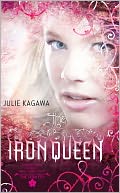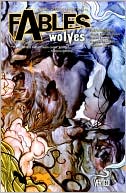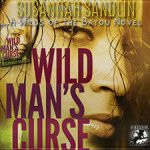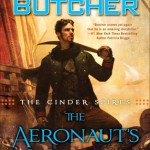 More than Team Ash, more than Team Puck, I’m on Team Julie! The conclusion to Julie Kagawa’s Iron Fey series, The Iron Knight, is simply awesome. As in full of awe and wonder and all of the things that we read fantasy in order to find.
More than Team Ash, more than Team Puck, I’m on Team Julie! The conclusion to Julie Kagawa’s Iron Fey series, The Iron Knight, is simply awesome. As in full of awe and wonder and all of the things that we read fantasy in order to find.
The Iron Knight is a blend of old fairy tales and modern myths, and it casts the time-worn tales into new guises. This story is a marvel. And the more I think about it, the more I find.
 Julie Kagawa has stated that the story was intended to be a trilogy, and it was supposed to be Meghan’s story: her journey from the half-caste daughter of the Summer King to become the Iron Queen in her own right. But the ending was bittersweet. She comes into her own at the cost of her great love. Ash, the Winter Prince, literally cannot live in the Iron Realm. The defeat of the evil Ferrum comes at a very high price. With great power comes great responsibility–Spiderman’s Uncle Ben strikes again. If Meghan were not willing to pay that price, she wouldn’t be worthy of being the Iron Queen in the first place.
Julie Kagawa has stated that the story was intended to be a trilogy, and it was supposed to be Meghan’s story: her journey from the half-caste daughter of the Summer King to become the Iron Queen in her own right. But the ending was bittersweet. She comes into her own at the cost of her great love. Ash, the Winter Prince, literally cannot live in the Iron Realm. The defeat of the evil Ferrum comes at a very high price. With great power comes great responsibility–Spiderman’s Uncle Ben strikes again. If Meghan were not willing to pay that price, she wouldn’t be worthy of being the Iron Queen in the first place.
But Ash is not a King. He only wants to be her Knight. And an Unseelie fey capable of truly loving anyone no longer has the emotional defenses capable of surviving in the Winter Courts. But in order to survive in Meghan’s Iron Realm, Ash can no longer be a Winter fey. He must become human. And for that, he needs a soul.
The Iron Knight is the story of Ash’s quest to become human. Like any quest story, Ash takes companions along on his journey. Ash’s crew is more motley, and more legendary, than most. Robin Goodfellow accompanies Ash. Of course he does. Puck loves Meghan as much as Ash does. So much so that he is willing to help his dearest rival achieve his greatest happiness, because it is Meghan’s best chance at joy.
 Grimalkin is the guide, well, some of the time. Grimalkin has all the tricksiness of the Cheshire Cat, and all the dignity of Bast. The Big Bad Wolf decides to join them, in the hopes of extending the life of his legend, and consequently, his own life. And, as with Grimalkin, the legend is the modern version, so think of the Wolf as influenced by Bill Willingham’s Fables. Except he’s always in wolf form.
Grimalkin is the guide, well, some of the time. Grimalkin has all the tricksiness of the Cheshire Cat, and all the dignity of Bast. The Big Bad Wolf decides to join them, in the hopes of extending the life of his legend, and consequently, his own life. And, as with Grimalkin, the legend is the modern version, so think of the Wolf as influenced by Bill Willingham’s Fables. Except he’s always in wolf form.
Then there’s the surprise mystery guide. Spoilers after the rating.
Escape Rating A+: Read the book. Read the whole series, because the payoff comes if you’ve read everything. I received The Iron Knight from Netgalley, and I hadn’t read the series. I bought the rest from Amazon, and swallowed in one gulp. Yum.
Ash’s journey is kind of a reverse Orpheus and Eurydice. Everything about the Iron Fey is a very neat meld of traditional fairy tales and modern myth, and this was just beautifully done. Ariella, Ash’s first love, has been waiting for Ash and Puck to make the journey to the End of the World for Ash’s soul. It was necessary for Ash and Puck to be there to help Meghan, and the only way for that to happen was for Ariella to die, and stay dead. Ariella is a seer, and she saw that her death brought about the best of all possible options regarding the incursion of the Iron Fey.
But Ariella still loves Ash, and she wants him to be happy. Just like Puck wants Meghan to be happy.
The Orpheus and Eurydice myth is that Orpheus goes to Hades to bargain for his love’s soul with Hades, God of the Underworld. The deal is that if Orpheus takes the long, dark journey back to the surface, with Eurydice following behind him, and Orpheus trusts that she is behind him without him ever looking back to check, when they reach the surface she will be free. Orpheus looks back very close to the exit.
But the concept, the idea of traveling down a river (there are 5 rivers in Hades in Greek myth) to the End of the World (Underworld) so that Ariella can give Ash her soul so that he can be reborn, it works.
It all works.









Awesome! I totally used to read this kind of stuff. Eventually you make the change to adult fiction though. What was the first book that you read that made you feel grown up? 🙂
http://www.washingtonpastime.com/drupal/node/61